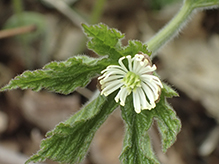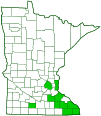goldenseal
(Hydrastis canadensis)
Conservation • Description • Habitat • Ecology • Use • Distribution • Taxonomy
|
|
||||||||||||||
Description |
Goldenseal is an early season herbaceous plant. It occurs in the United States from New Hampshire to Northern Georgia, west to Minnesota and Arkansas. It also occurs in southern Ontario Canada. It is rare in Minnesota. It is found in the understory of undisturbed deciduous forests in sheltered ravines and talus slopes. It grows under dappled sunlight, in moist to moderately moist conditions, in loamy soil. It flowers in May before the forest canopy closes. Goldenseal is listed as an endangered species in Minnesota. Its numbers are in decline due to habitat destruction and “wild collecting”. It grows in sheltered ravines and on talus slopes. It is intolerant of changes that open the forest canopy. The plant is the source of the alkaloids hydrastine and berberine, which herbalists use to treat sores of the mouth, throat, and digestive system. The alkaloid concentrations required for pharmaceutical use occur only in the rhizomes. More than 60 million plants are picked every year, and these plants are not replaced. It takes four to five years for a plant to reach sexual maturity. There is currently no scientific evidence supporting the use of goldenseal for any medicinal purposes. Goldenseal is perennial and slow growing. It can be 6″ to 20″ (15 to 50 cm) tall, but it is usually no more than 14″ (35 cm) tall. It rises on a single basal leaf and a single flowering stem from an underground, creeping, horizontal stem (rhizome). The rhizome is yellow, thick, and branched, and it has long, tough, fibrous roots. On older plants, the rhizome can be up to 2¾″ (7 cm) long and the roots can be up to 40″ (1 m) long. The rhizome may break apart, with each fragment forming a new plant, and new plants may be produced from buds on the long roots. The basal leaf is similar to the stem leaves, but it is often small and scale-like, and it sometimes withers very early. It is on a long, hairy, leaf stalk (petiole). The flowering stem is erect or ascending, unbranched, and moderately covered with short, fine, spreading hairs. There are two leaves near the top of the stem. The stem leaves are ¾″ to 2⅜″ (2 to 6 cm) long, and 1¼″ to 4″ (3 to 10 cm) wide at flowering time. They are on relatively short petioles. The leaf blades are broadly heart shaped, kidney shaped, or nearly circular in outline and deeply heart-shaped at the base. They are shallowly, moderately, or deeply palmately cut into 3 to 9 lobes. The lobes are variously shaped, elliptic, oblong elliptic, egg shaped, or somewhat diamond shaped (rhombic). They taper to a sharply pointed tip. The upper surface is hairless or nearly hairless. The lower surface is finely hairy just along the veins. The margins are singly or doubly toothed with sharp, forward pointing teeth (serrate). The inflorescence is a single flower at the tip of the stem. It is closely subtended by the upper stem leaf. The flower is on a 3⁄16″to 1⅜″ (5 to 35 mm) long stalk (pedicel). The flower is 5⁄16″ to 11⁄16″ (8 to 18 mm) wide, white, radially symmetric, and bisexual (perfect). It is 3-parted, which is highly unusual for plants in the buttercup (Ranunculaceae) family. There are 3 outer floral leaves (sepals), no petals, 50 to 75 stamens, and 5 to 15 pistils. The sepals are ⅛″ to ¼″ (3.5 to 7.0 mm) long, greenish white or creamy white, flat, and egg-shaped, oval, or elliptic. They drop away before the stamens and pistils are fully developed. The stalks of the stamens (filaments) are white, showy, ⅛″ to 5⁄16″ (4 to 8 mm) long, and abruptly narrowed at the tip. They are dense and curved upward, giving a hemispherical shape to the flower. The anthers are yellow. There are no sterile stamens (staminodes) between the stamens and pistils. The ovary has 2 ovules. Each pistil has 1 carpel. The style is rather short. The infructescence is a dense, ⅝″ to 1″ (15 to 26 mm) in diameter aggregate of 5 to 15 dark red berries. By fruiting time, the leaf below the infructescence has greatly enlarged, becoming 4¾″ to 10″ (12 to 25 cm) wide. Each berry is 3 ⁄16″ to 5⁄16″ (5 to 8 mm) long and more or less globe shaped but somewhat flattened by the adjacent berries. It has a 1⁄32″ to 1⁄16″ (1 to 2 mm) long, more or less straight but usually angled extension (beak) at the end. There are 1 or 2 seeds in each berry. The berries ripen in June to early July. |
Height |
6″ to 20″ (15 to 50 cm) |
Flower Color |
White |
Similar Species |
Habitat |
Deciduous forests in sheltered ravines and talus slopes |
Ecology |
Flowering |
May |
Pests and Diseases |
|
Use |
Goldenseal is the source of the alkaloids hydrastine and berberine. Herbalists use the plant’s rhizomes to treat sores of the mouth, throat, and digestive system. |
Distribution |
||
|
Sources |
|
| 3/15/2024 | ||
Nativity |
||
Native |
||
Occurrence |
||
Rare in Minnesota |
||
Taxonomy |
|
Kingdom |
Plantae (green algae and land plants) |
Subkingdom |
Viridiplantae (green plants) |
Infrakingdom |
Streptophyta (land plants and green algae) |
Superdivision |
|
| Division |
Tracheophyta (vascular plants) |
Subdivision |
Spermatophytina (seed plants) |
Class |
|
Superorder |
Ranunculanae |
Order |
Ranunculales (buttercups, poppies, and allies) |
Family |
Ranunculaceae (buttercup) |
Subfamily |
Hydrastidoideae (goldenseal) |
Tribe |
Hydrastideae |
Genus |
Hydrastis (goldenseals) |
This is the only species in the genus Hydrastis. |
|
Subordinate Taxa |
|
|
|
Synonyms |
|
Hydrastis trifolia Warnera canadensis Warnera diphylla Warnera tinctoria Warneria canadensis Warneria diphylla Warneria tinctoria |
|
Common Names |
|
goldenseal orangeroot yellow-puccoon |
|
Glossary
Ascending
Growing upward at an angle or curving upward from the base.
Filament
On plants: The thread-like stalk of a stamen which supports the anther. On Lepidoptera: One of a pair of long, thin, fleshy extensions extending from the thorax, and sometimes also from the abdomen, of a caterpillar.
Pedicel
On plants: the stalk of a single flower in a cluster of flowers. On insects: the second segment of the antennae. On Hymenoptera and Araneae: the narrow stalk connecting the thorax to the abdomen: the preferred term is petiole.
Perfect
Referring to a flower that has both male and female reproductive organs.
Petiole
On plants: The stalk of a leaf blade or a compound leaf that attaches it to the stem. On ants and wasps: The constricted first one or two segments of the rear part of the body.
Rhizome
A horizontal, usually underground stem. It serves as a reproductive structure, producing roots below and shoots above at the nodes.
Sepal
An outer floral leaf, usually green but sometimes colored, at the base of a flower.
Spreading
Extending nearly horizontal.
Staminode
A modified stamen that produces no pollen. It often has no anther. Plural: staminodia.
Visitor Photos |
||
Share your photo of this plant. |
||
This button not working for you? |
||
Babette Kis |
||
Goldenseal, Hydrastis canadensis … photographed at the hedgerow and rich soil mesic oak woods adjacent to Barnes Prairie, Racine Co., WI. |
||
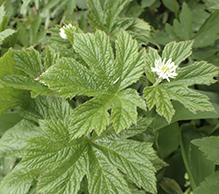 |
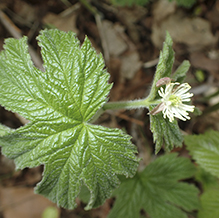 |
|
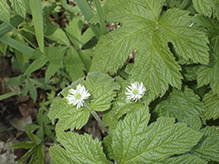 |
||
MinnesotaSeasons.com Photos |
||
|
||
|
||

Slideshows |
|

Visitor Videos |
||
Share your video of this plant. |
||
This button not working for you? |
||
|
Other Videos |
||
Hydrastis canadensis |
About
Jul 5, 2017 |
Goldenseal herb, Hydrastis canadensis |
About
Mar 8, 2010 http://FreeHerbCourse.com We feature the Goldenseal herb, Hydrastis canadensis, and how to grow goldenseal, how to plant goldenseal, how to harvest goldenseal in this video. Learn more about harvesting herbs and growing herbs. |

Visitor Sightings |
||
Report a sighting of this plant. |
||
This button not working for you? |
||
Babette Kis |
Location: Barnes Prairie, Racine Co., WI. … photographed at the hedgerow and rich soil mesic oak woods adjacent to Barnes Prairie, Racine Co., WI. |
 |
Babette Kis |
Location: Barnes Prairie, Racine Co., WI. … photographed at the hedgerow and rich soil mesic oak woods adjacent to Barnes Prairie, Racine Co., WI. |
 |
Babette Kis |
Location: Barnes Prairie, Racine Co., WI. … photographed at the hedgerow and rich soil mesic oak woods adjacent to Barnes Prairie, Racine Co., WI. |
 |
MinnesotaSeasons.com Sightings |
||
|

|
Created: 3/16/2024 Last Updated: © MinnesotaSeasons.com. All rights reserved. |
